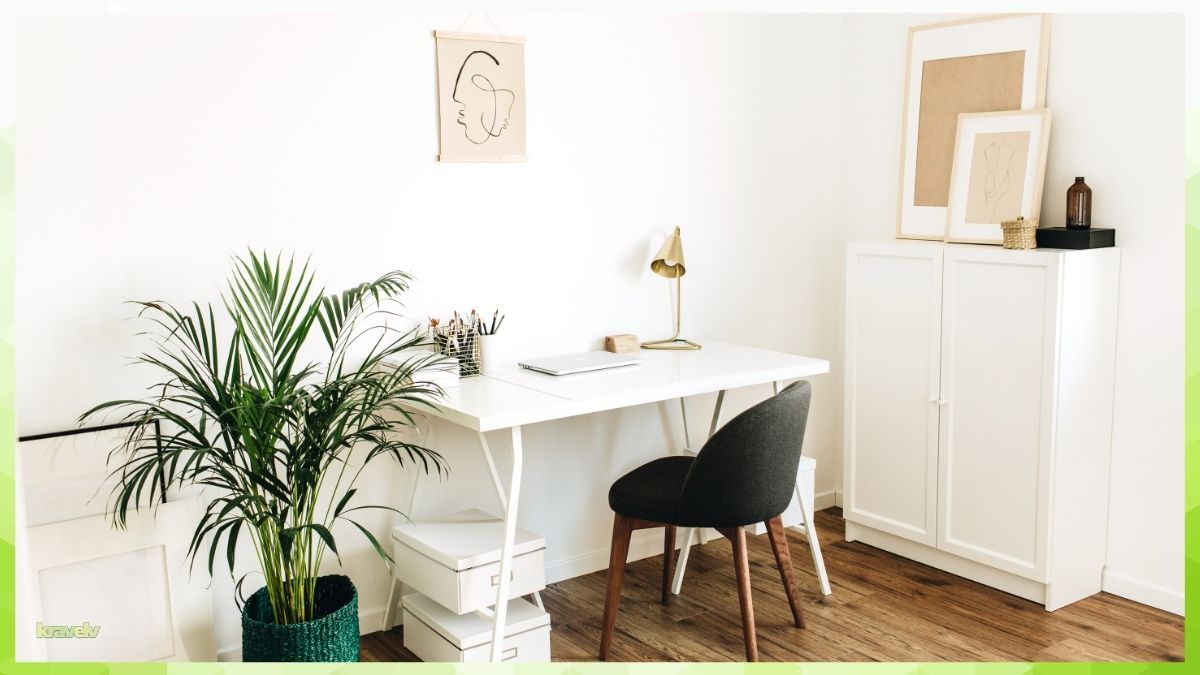Last Updated on April 19, 2025 by Kravelv Spiegel
You don’t need a spare room to create a space that fuels focus and flow. With the right design ideas for a small home office, even the corner of a bedroom or a repurposed closet can become your productivity zone. In a world where remote work is no longer optional, how your workspace feels can impact how well you work. The challenge isn’t space—it’s how you use it.
💡Key takeaways:
- A small home office can be just as functional and stylish as a large one with the right design approach.
- Choosing the right location and furniture is crucial to maximizing efficiency in a compact workspace.
- Vertical storage, layered lighting, and a cohesive color scheme are key to making small spaces feel open and inviting.
- Staying organized, adding personal touches, and planning for flexibility help your office stay productive and adaptable.
Why a Small Home Office Can Be Better
Before we dive in, let’s bust a myth: bigger isn’t always better.
Small home offices have their perks. They’re easier to keep organized, faster to clean, and can feel cozy and focused when designed well. A compact space forces you to be intentional—no wasted space, no unnecessary furniture.
Plus, smaller offices are more flexible. You can carve out a work zone almost anywhere: behind a door, under the stairs, or even in a closet.
1. Find the Best Spot in Your Home
The first and most important step is finding where your office will live. It doesn’t have to be an entire room—it just needs to be consistent.
Ideal spots for a small home office:
- A corner of the living room or bedroom
- A wide hallway or landing
- An unused closet (hello, cloffice!)
- The space under the stairs
- A window nook or dormer
- The end of a kitchen counter or pantry area
- Behind a sofa with a console desk
Pro tip: Face your desk toward a wall or window to reduce distractions and give yourself a visual boundary.
2. Make a List of Must-Haves
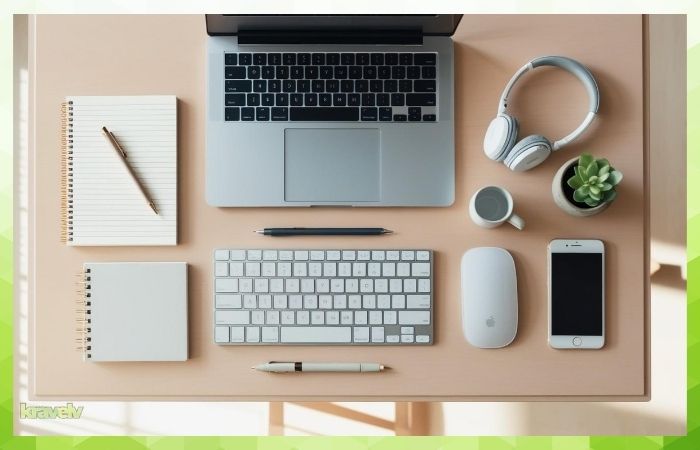
Before buying anything, get clear on what your workspace actually needs. That means evaluating your daily routine and equipment.
Ask yourself:
- Do I need one monitor or two?
- Will I be on video calls regularly?
- Do I require silence and a door, or can I manage with noise?
- How much paper, gear, or office supplies do I need to store?
- Is this space just for work, or will it double as a guest room, craft space, or study area?
This list helps you prioritize your layout, furniture, and budget.
Also read: How to Build a Productive Home Office on a Tight Budget
3. Choose the Right Desk for Your Setup
Desks are the centerpiece of any office, but in a small space, size and shape matter more than ever.
Space-saving desk options:
- Wall-mounted floating desks: Great for tight spaces and minimalist vibes.
- Corner desks: Perfect for making use of awkward angles.
- Narrow console desks: Ideal for shallow spaces behind sofas or in hallways.
- Drop-down desks: Fold up when not in use—perfect for multipurpose rooms.
- Standing desks: Many come in compact sizes and offer ergonomic flexibility.
Make sure your desk is deep enough to accommodate your computer and leave writing space. If you’re using dual monitors or heavy equipment, check weight limits.
4. Don’t Underestimate the Chair
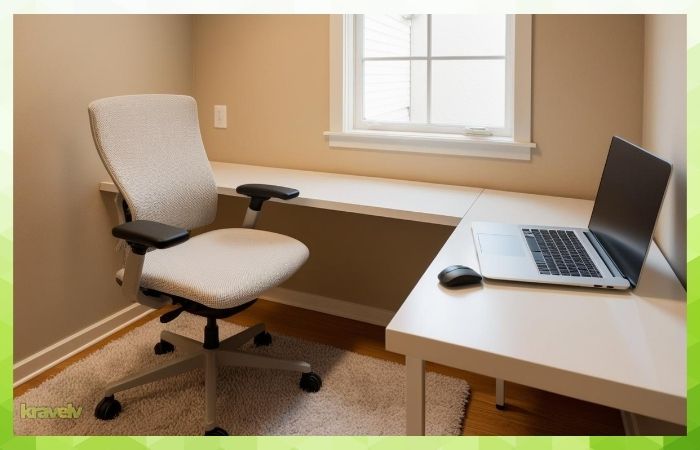
You might be tempted to use any chair lying around—but don’t.
An uncomfortable chair ruins productivity and posture. Even in a small home office, prioritize ergonomic seating.
Tips:
- Look for chairs with lumbar support and adjustable height.
- Armless chairs work well in tighter areas.
- Consider a rolling chair with wheels to help navigate tight corners.
- If space is really limited, opt for a stylish dining chair and add a cushion for comfort.
Bonus: If your office is part of a shared space, go for a chair that looks good from all angles.
5. Go Vertical with Storage Solutions
In small spaces, floor space is sacred. That’s why your walls are key.
Vertical storage ideas:
- Floating shelves: Store books, files, and décor without eating floor space.
- Tall cabinets or bookcases: Slim but tall units draw the eye upward.
- Wall-mounted pegboards or grids: Organize supplies and tech neatly.
- Stackable bins or boxes: Use labeled containers on high shelves.
- Over-desk hutches: Add storage without expanding the footprint.
Keep high-use items within arm’s reach. Less-used materials can go higher up.
6. Maximize Lighting—Natural and Artificial
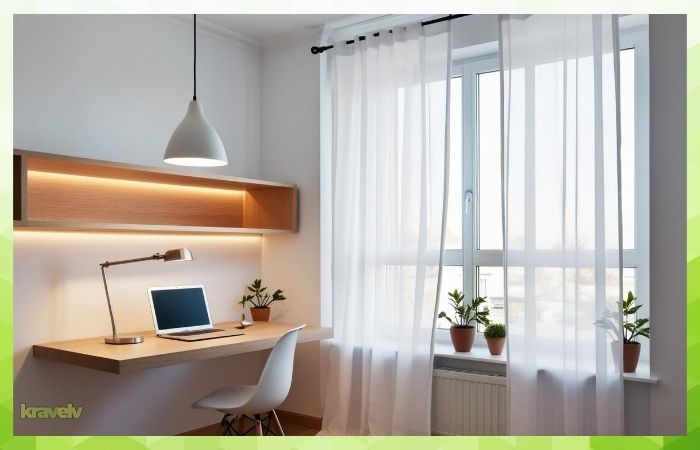
Bad lighting makes even the nicest setup feel like a closet. Good lighting can make a closet feel like an oasis.
Lighting tips for small home offices:
- Use layered lighting: Combine overhead, task, and ambient lighting.
- Place your desk near a window: Natural light improves mood and reduces eye strain.
- Use LED desk lamps with dimmers: These save space and energy.
- Add under-shelf lighting: Helps brighten shadowy spots and looks sleek.
Avoid bulky floor lamps. Opt for sconces, clamp lights, or under-cabinet LEDs when floor space is tight.
Also read: Home Office Lighting Tips to Instantly Boost Mood and Focus
7. Use Color to Open Up the Space
Color affects mood and perception. In a small home office, the right palette can make the space feel larger, calmer, and more inviting.
Go for:
- Soft neutrals like white, beige, or greige for an open feel.
- Cool tones like pale blue or sage to boost focus.
- Monochromatic schemes to create visual continuity.
- Accent walls to define the office zone without taking up space.
Avoid overly dark colors unless you’re going for a dramatic mood—and balance them with good lighting.
8. Keep It Organized—and Stay That Way
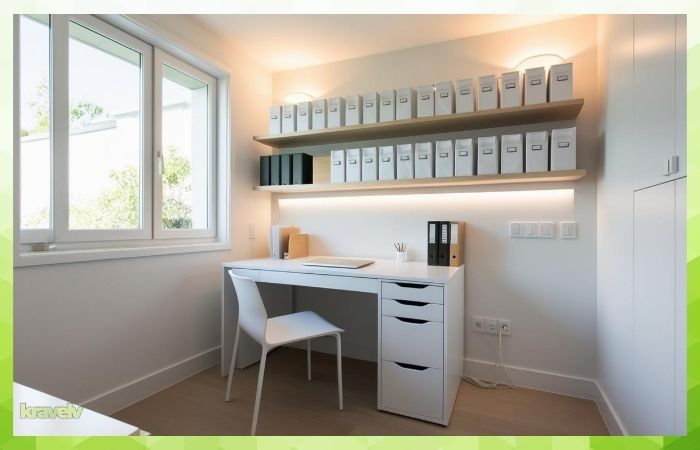
Clutter kills focus. And in small offices, it makes the whole room feel chaotic.
Organization hacks:
- Use drawer dividers to keep tools and cables tidy.
- Hide cords with cable boxes or adhesive clips.
- Create a filing system using vertical organizers or a small portable file box.
- Go digital where possible—scan paperwork, use apps for notes, and back everything up to the cloud.
- Add one or two catch-all baskets for quick cleanups.
Build a quick 5-minute end-of-day reset habit. It makes a huge difference.
9. Separate the Space (Even if It’s Just a Corner)
You need a way to mentally clock into work. Visual boundaries help you focus—even if you’re working in a shared space.
Ideas to define your office zone:
- Area rugs under your desk.
- Curtains or sliding panels.
- Room dividers or tall bookshelves.
- Accent paint or wallpaper behind your desk.
- Plants that subtly section off space.
A clear boundary also helps others in the household respect your work zone.
10. Add Personal Touches—But Keep It Minimal
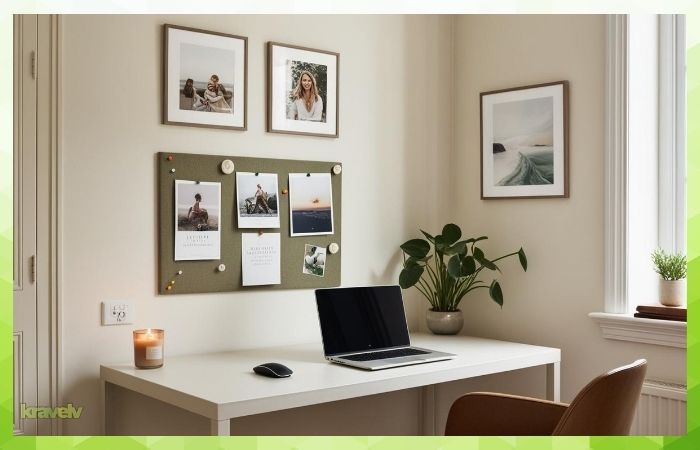
You don’t need a Pinterest-perfect office, but you do need a space that feels like you. Just avoid going overboard.
Add:
- A framed photo or piece of art you love
- One or two plants (snake plants, succulents, or pothos are great)
- A scent diffuser or candle
- A mood board or small pinboard
- A few meaningful objects—like a trophy, travel souvenir, or quote
Skip excessive knickknacks. Personal doesn’t mean cluttered.
11. Tech Up Without Cluttering Down
Even a small home office needs good tech—but tech tends to come with wires, gadgets, and chaos.
Space-saving tech tips:
- Use Bluetooth or wireless devices where possible.
- Mount a monitor arm to free up desk space.
- Get a USB hub to consolidate cords.
- Invest in a good microphone and webcam for video calls.
- Use compact printers or wireless models that can be stowed away when not in use.
Store backup gear in labeled boxes or drawers to avoid that tangled mess of cables we all know too well.
12. Design for Flexibility
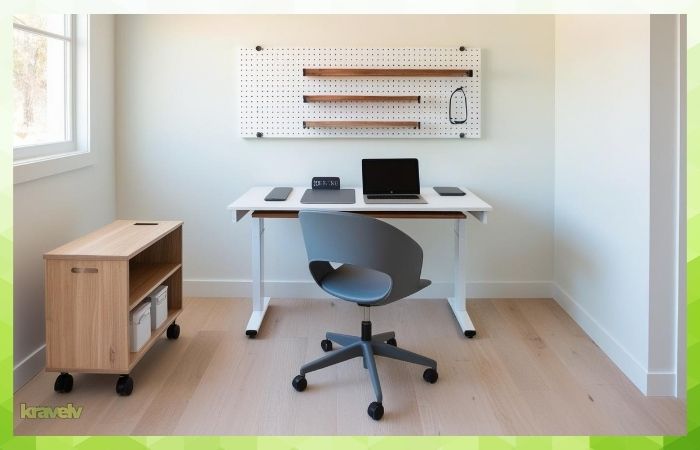
Your needs might change. Your office should be able to change with you.
- Use rolling carts for movable storage.
- Pick modular furniture that can reconfigure as your work evolves.
- Leave blank wall space for future shelves or pegboards.
- Don’t cram every inch—open space is design, too.
Even a small home office should leave a little breathing room.
Small Home Office Design FAQs
What’s the best desk size for a small home office?
Aim for 36–48 inches wide and 18–24 inches deep. Wall-mounted or narrow desks are ideal.
Can I put a home office in my bedroom?
Absolutely. Just separate the zones visually with rugs, paint, or layout.
How do I hide cables in a small workspace?
Use cable trays under desks, adhesive clips, or a fabric cord cover.
What’s a “cloffice”?
A closet turned into an office—perfect for ultra-tight spaces.
Final Thoughts: Small Office, Big Potential
Designing a small home office isn’t about squeezing into a space. It’s about being intentional.
When done right, a compact workspace can be just as functional—and far more personal—than a sprawling corporate setup. With smart storage, the right lighting, efficient furniture, and a touch of style, your home office can be a place you actually want to spend time in.

